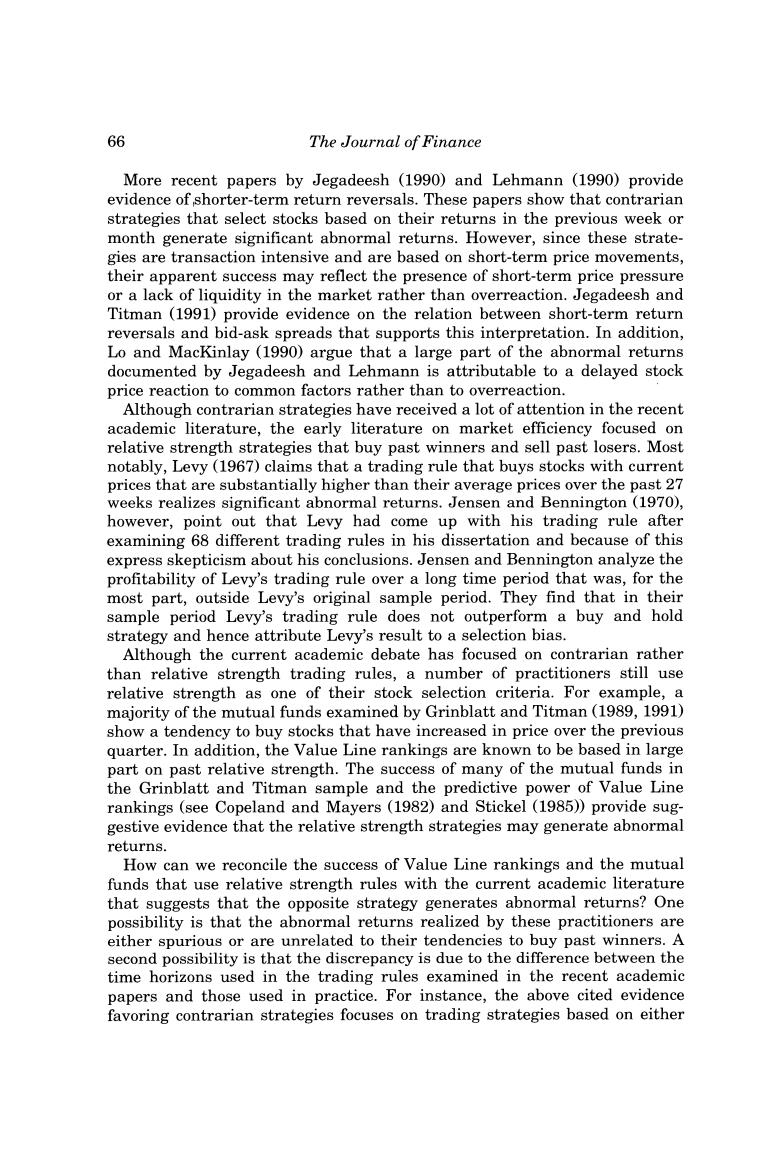正在加载图片...

66 The Journal of Finance More recent papers by Jegadeesh (1990)and Lehmann (1990)provide evidence of shorter-term return reversals.These papers show that contrarian strategies that select stocks based on their returns in the previous week or month generate significant abnormal returns.However,since these strate- gies are transaction intensive and are based on short-term price movements, their apparent success may reflect the presence of short-term price pressure or a lack of liquidity in the market rather than overreaction.Jegadeesh and Titman (1991)provide evidence on the relation between short-term return reversals and bid-ask spreads that supports this interpretation.In addition, Lo and MacKinlay (1990)argue that a large part of the abnormal returns documented by Jegadeesh and Lehmann is attributable to a delayed stock price reaction to common factors rather than to overreaction. Although contrarian strategies have received a lot of attention in the recent academic literature,the early literature on market efficiency focused on relative strength strategies that buy past winners and sell past losers.Most notably,Levy(1967)claims that a trading rule that buys stocks with current prices that are substantially higher than their average prices over the past 27 weeks realizes significant abnormal returns.Jensen and Bennington (1970), however,point out that Levy had come up with his trading rule after examining 68 different trading rules in his dissertation and because of this express skepticism about his conclusions.Jensen and Bennington analyze the profitability of Levy's trading rule over a long time period that was,for the most part,outside Levy's original sample period.They find that in their sample period Levy's trading rule does not outperform a buy and hold strategy and hence attribute Levy's result to a selection bias. Although the current academic debate has focused on contrarian rather than relative strength trading rules,a number of practitioners still use relative strength as one of their stock selection criteria.For example,a majority of the mutual funds examined by Grinblatt and Titman(1989,1991) show a tendency to buy stocks that have increased in price over the previous quarter.In addition,the Value Line rankings are known to be based in large part on past relative strength.The success of many of the mutual funds in the Grinblatt and Titman sample and the predictive power of Value Line rankings(see Copeland and Mayers (1982)and Stickel (1985))provide sug- gestive evidence that the relative strength strategies may generate abnormal returns. How can we reconcile the success of Value Line rankings and the mutual funds that use relative strength rules with the current academic literature that suggests that the opposite strategy generates abnormal returns?One possibility is that the abnormal returns realized by these practitioners are either spurious or are unrelated to their tendencies to buy past winners.A second possibility is that the discrepancy is due to the difference between the time horizons used in the trading rules examined in the recent academic papers and those used in practice.For instance,the above cited evidence favoring contrarian strategies focuses on trading strategies based on either